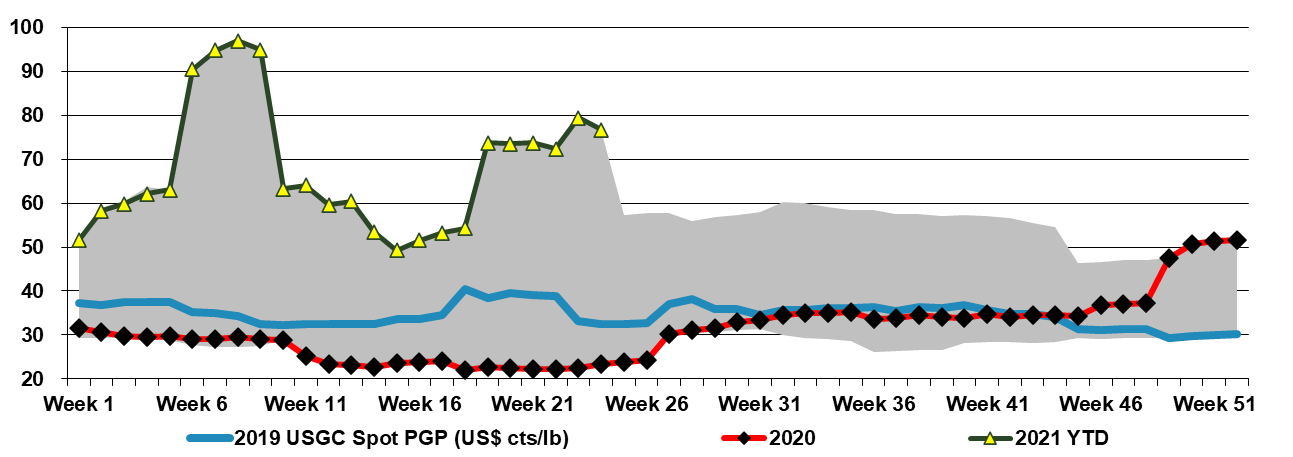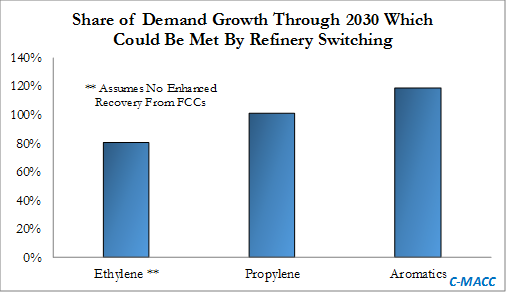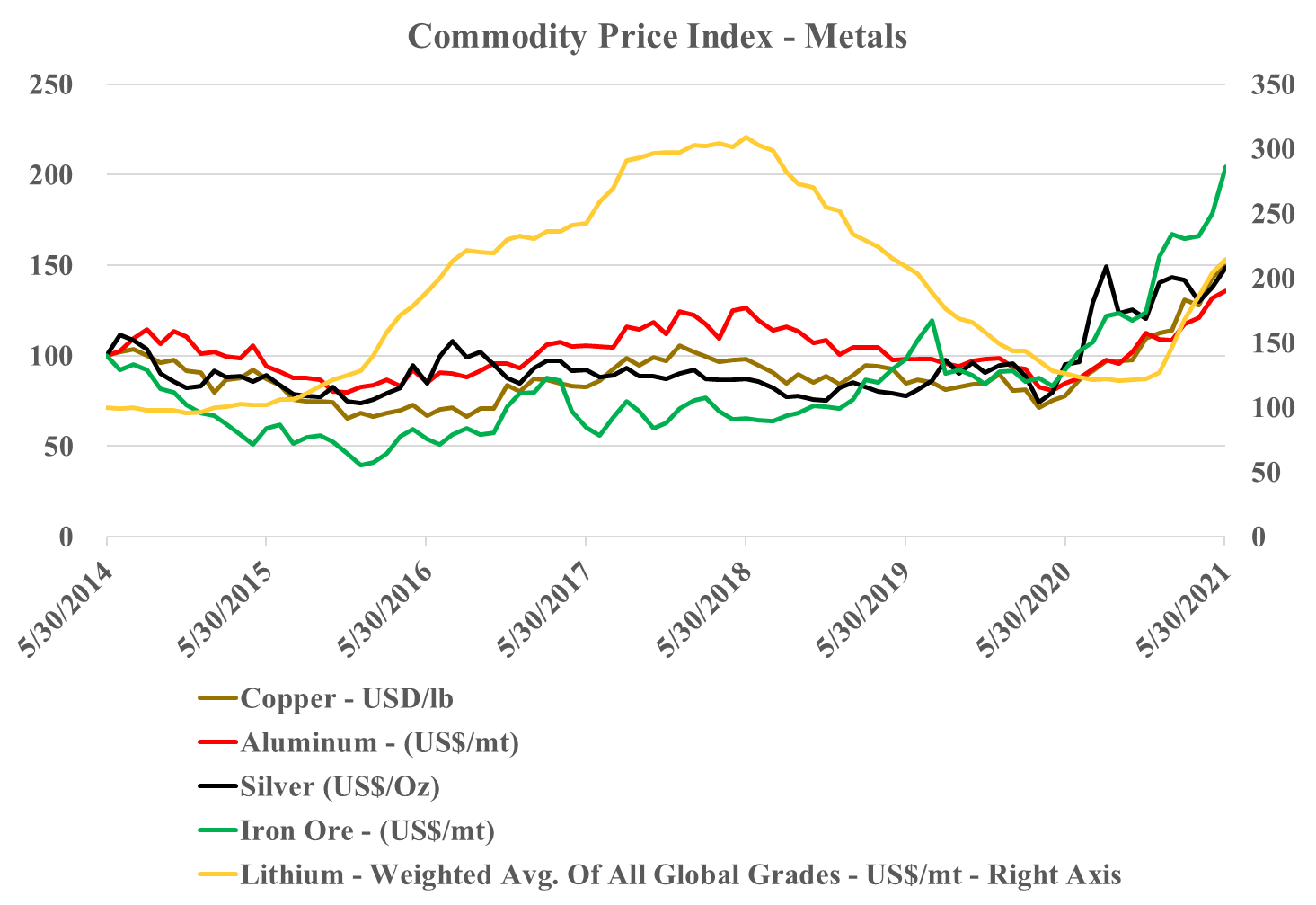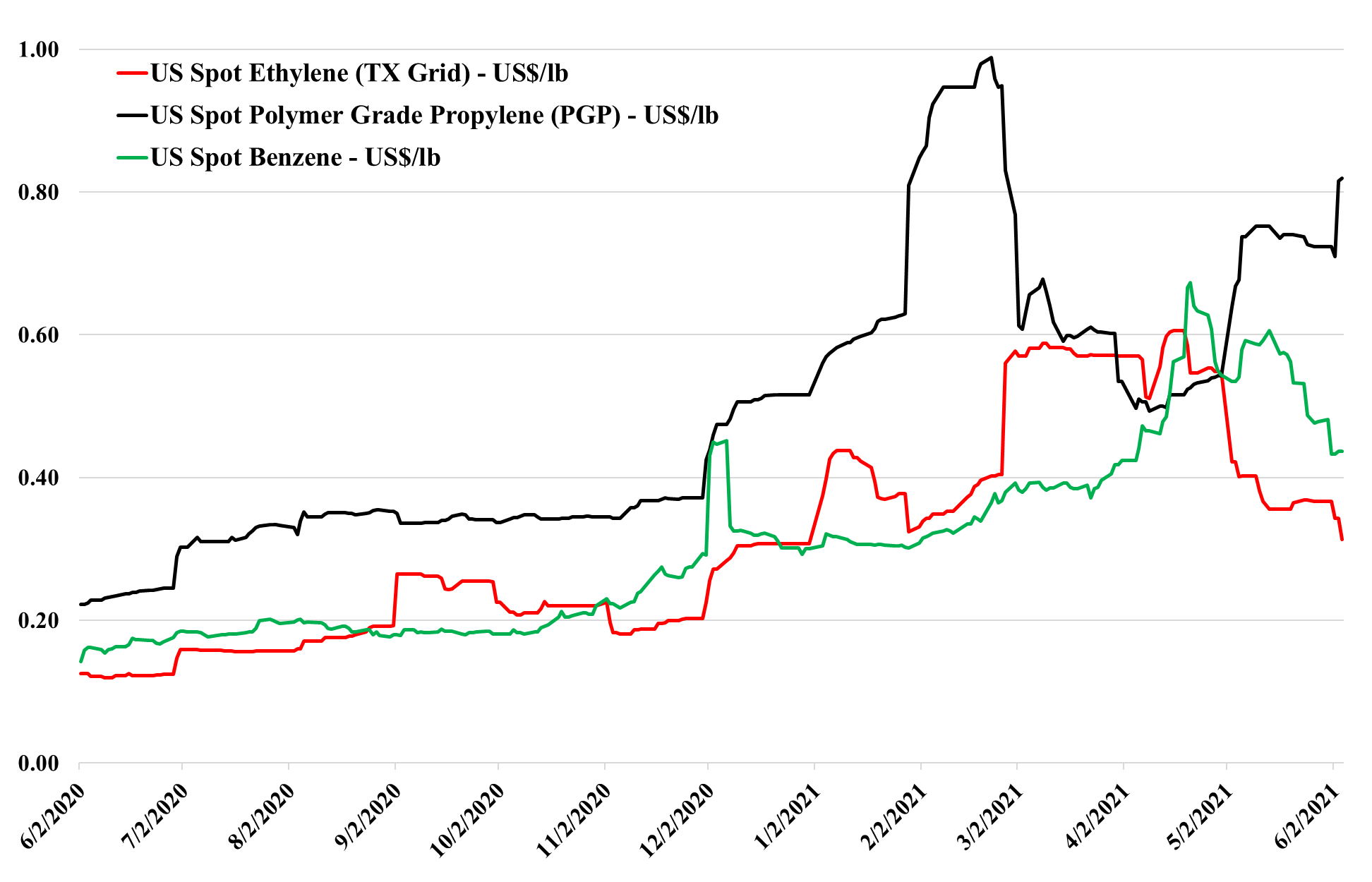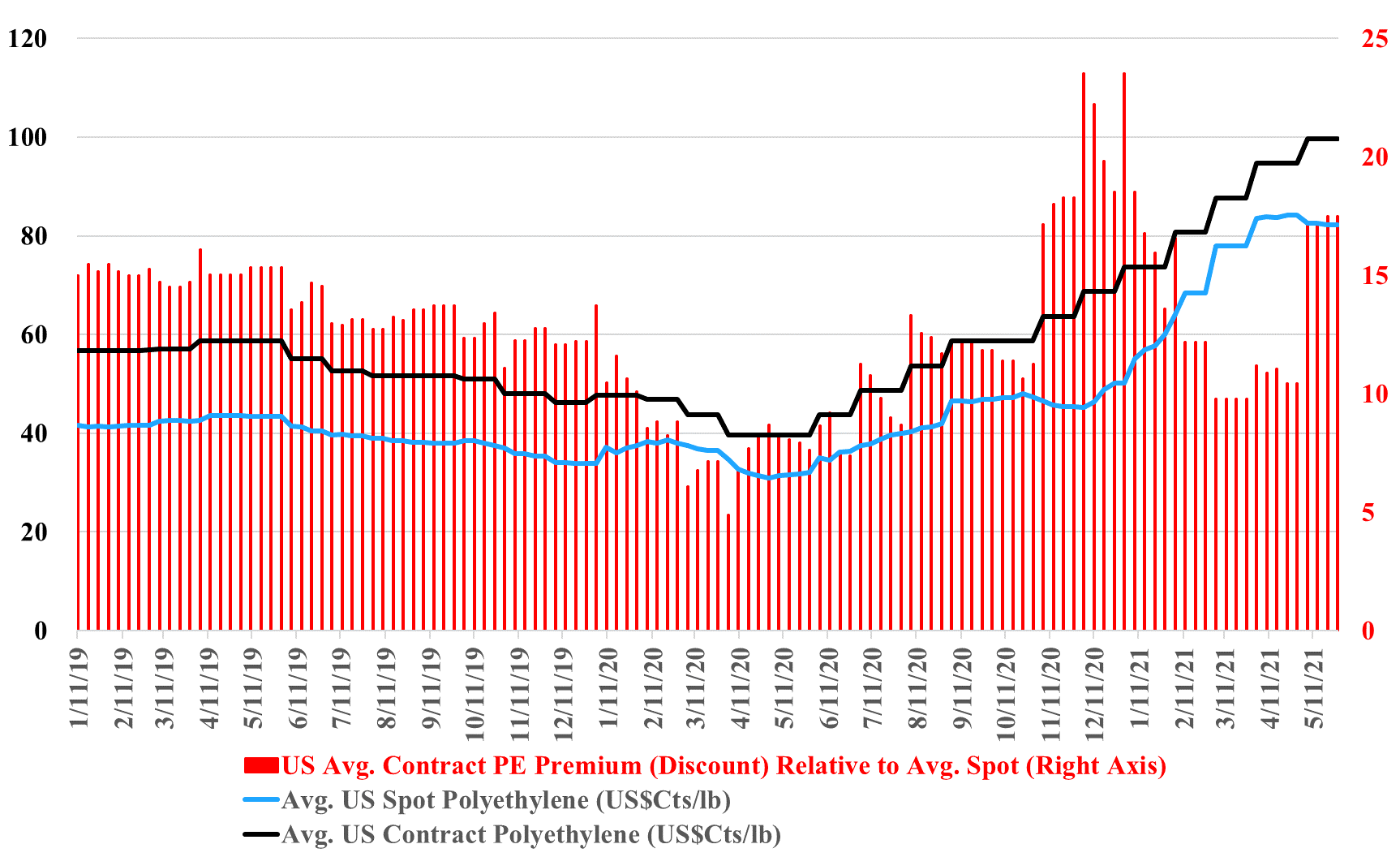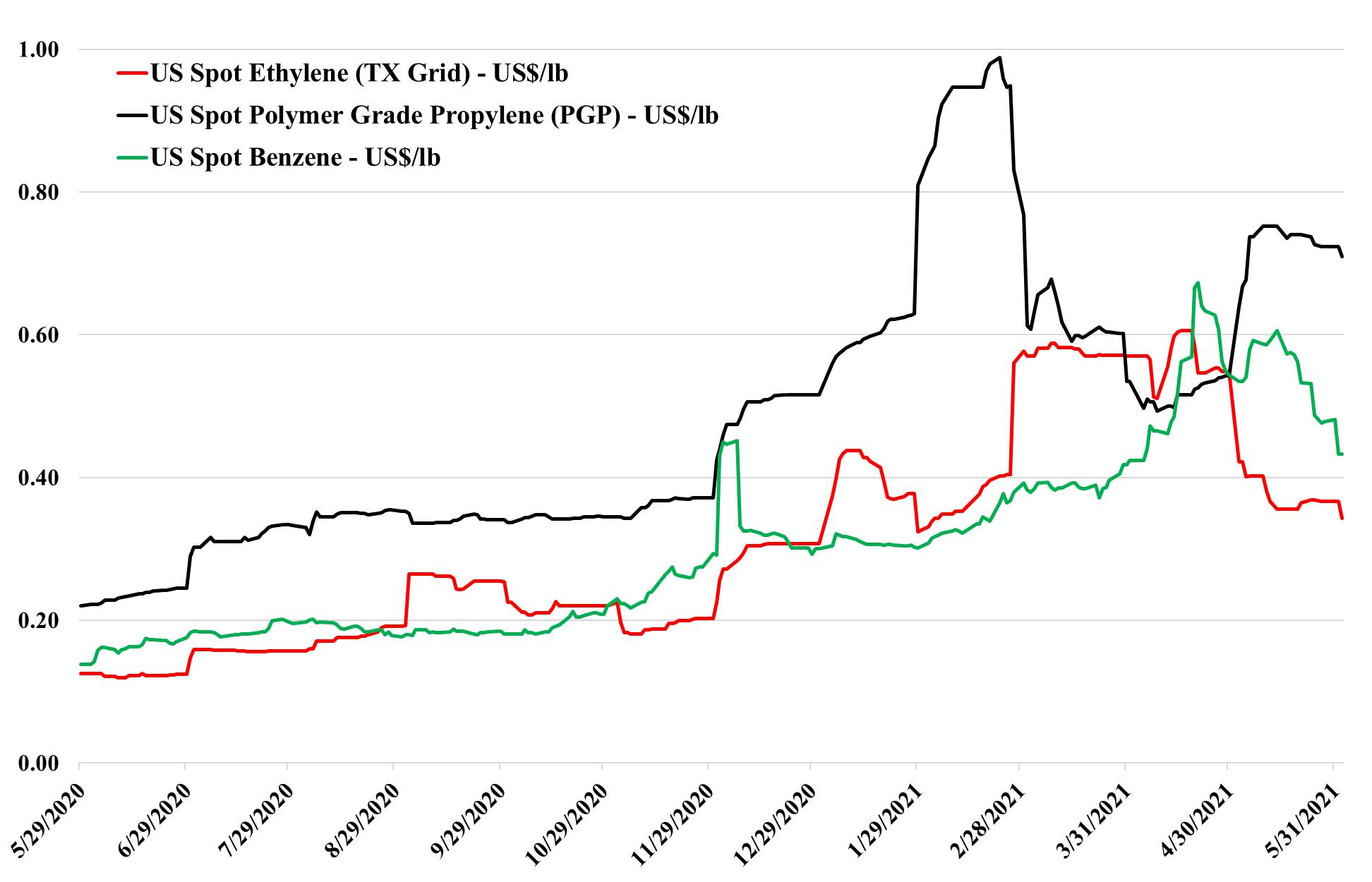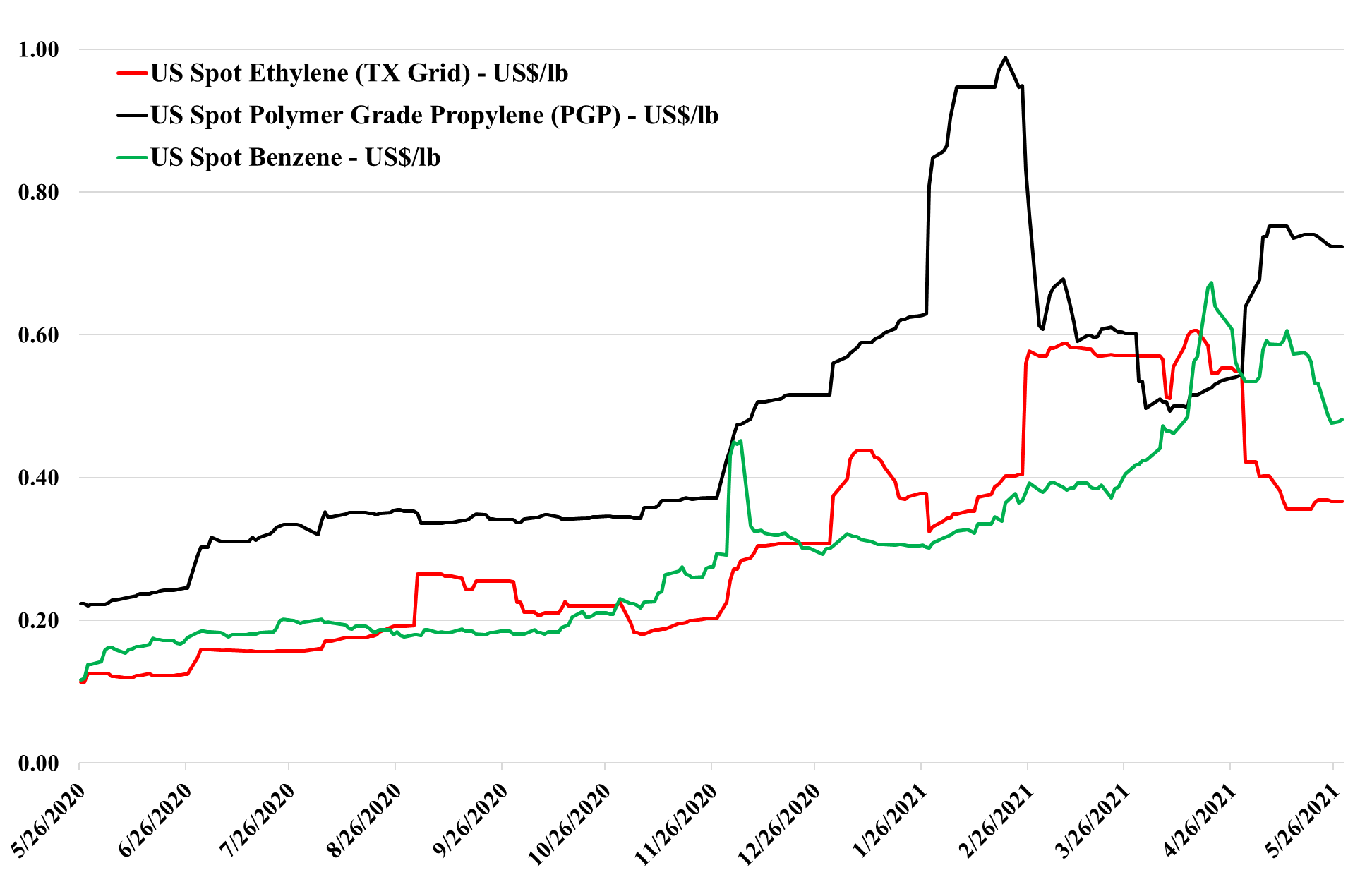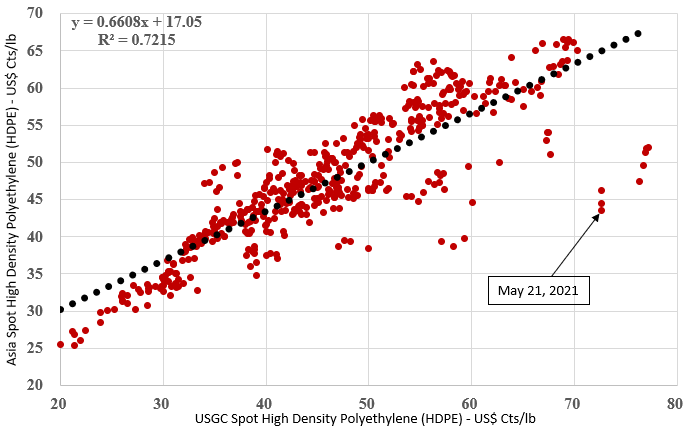The weakness in polymer pricing in Asia and the drag that auto sales had on US consumer spending in May (spending was up ex-autos) should begin to undermine the very strong polypropylene market in the US, and the fall may happen at a reasonable clip. Polypropylene is more fungible than polyethylene, in that much more of the customization of polypropylene comes post-production rather than during production. There are several unique polyethylene technologies, especially for linear-low where the process drives the properties and adds value. For polypropylene, while there is some of this, most product is compounded and consequently, there is more fungibility before compounding and less risk from experimenting with suppliers. If freight rates were not so high as discussed in today's daily, we believe that we would have seen a notable amount of polypropylene moving from Asia to the US by now.
Recent Posts
Propylene Too Expensive, Ethylene Cheap Enough
Jun 15, 2021 2:18:27 PM / by Cooley May posted in Chemicals, Propylene, Polyethylene, Polypropylene, Ethylene, Auto Industry, polymer pricing, consumer spending
Ethylene Weaker Again - Is Propylene On The Edge?
Jun 11, 2021 1:19:33 PM / by Cooley May posted in Propylene, Ethylene, Monomer, polymer pricing, polymer grade propylene, PGP, USGC, RPG, refinery grade propylene
USGC ethylene spot prices have weakened since reaching a multi-year peak in mid-April, something we have discussed for some time. This week's downtick in propylene values is a bit more unique as it has occurred alongside weakness in other monomer markets, which is a general trend that appears likely to gain momentum. Most monomer markets are weakening from recent 2Q21 highs in the US. We broadly find an increasing level of support for our view that many commodity chemical product prices will peak for the year in 2Q21. Exhibit 1 in our Daily Report shows an Asia arbitrage that should allow US ethylene to move to Asia, but is in the potential to take it because of local Asia surpluses, Asia prices will remain under pressure, although ethylene values in this region are fast approaching costs. We will soon be back to the previous equilibrium in an oversupplied ethylene market, where the economics of Asia production sets prices, and US exporters make a margin based on their cost advantage. The question now is how long it is before polymer prices follow.
Could Big Oil Capital Reallocation Drive More Chemical Supply?
Jun 10, 2021 1:27:19 PM / by Cooley May posted in Chemicals, Polymers, Climate Change, Oil Industry, Ethylene, Carbon, ExxonMobil, fossil fuel, hydrocarbons, Dow, Base Chemicals, Sabic, JV, Engine No. 1
The ExxonMobil board headline linked has come up a couple of times since the Engine No.1 victory at the board meeting. There is no doubt that capital spending plans will be reviewed with the changes at the top, and we expect more management changes, which could also drive spending priorities. Over the last couple of years, several more macro studies have been done talking about oil demand in a climate change-centric world and all have highlighted chemicals as one of the likely longer-term growth avenues for fossil fuels. We would expect ExxonMobil and other oil majors to look at investments in chemicals as a route to more captive consumption of hydrocarbons and believe that this could ultimately keep basic chemical and polymer markets oversupplied through the balance of this decade – we have been writing about this risk consistently since early 2020. ExxonMobil is already building ethylene capacity in the US in a JV with SABIC, but more oil company investments could come in the US. The caveat is that, as Dow covered in its MDI press release yesterday, any new investment is likely to need a carbon plan to get stakeholder and regulatory approval.
Will High Propane Prices Limit Propylene Demand Growth?
Jun 9, 2021 1:39:34 PM / by Cooley May posted in Chemicals, Recycling, Polymers, Polypropylene, Chemical Demand, Chemical Industry, propane, polystyrene, paint additives, ethane
The relative strength in US propane versus ethane is something we have talked about before, with the strong export pull on propane, pushing prices higher, despite equally strong demand for ethane in US ethylene units and for export. The projects to consume propane coming online in the next 12 months overwhelm the projects to consume ethane in our estimate and consequently, we believe that the delta (in chart below) will remain high and may widen further. On a cost basis, this could put US propylene and a distinct disadvantage to US ethylene and at the margin might help ethylene derivative demand relative to propylene derivative demand – most likely in paint additives, but also in some polymers where polypropylene can be substituted with other materials – it may provide a bit of a lifeline for polystyrene if the polystyrene recycling initiatives gain traction. See our daily report for more.
Base Chemicals May Be Weaker, But Nothing Else Is
Jun 8, 2021 12:35:56 PM / by Cooley May posted in Chemicals, Polymers, Commodities, Ethylene, Base Chemicals, intermediates, downstream, Capacity shortages, derivatives
There is an interesting difference between the base chemicals markets and some of the other broad commodities and intermediates, and we have economic growth that is testing the capacity limits for many commodities and downstream products, but the overbuild in basic chemicals, most recently in China, is putting significant downward pressure on pricing, as we highlighted in yesterday’s Weekly Report. Capacity shortages in intermediates and some specialties, which are driving the investments we highlighted in today's daily report and which are a steady flow of news this year, are leading to some expanding margins over base chemicals in select areas where capacity has not kept pace with demand.
A Very Disorderly Olefins Market: More To Come?
Jun 4, 2021 12:57:49 PM / by Cooley May posted in Propylene, Commodities, Ethylene, olefins, China, oversupply, derivative capacity
The oversupply in China for many commodities is becoming more evident daily. Our research depicts this as supply-driven, based on the surge of ethylene and propylene and derivative capacity since 3Q 2020. Notwithstanding the Dow commentary (in our daily report today), the weakness in Asia in polyethylene will ultimately impact the US, as the US relies on international demand for at least 25% of its polyethylene production – much less for polypropylene. The gyrations in the ethylene and propylene markets, as shown in the chart below, indicate the US dealing with the differences between the two monomer chains. Far more ethylene and ethylene derivatives move offshore than propylene and propylene derivatives. Despite the ongoing strength in derivatives, the ethylene market is loosening. At the same time, propylene shows extreme volatility because demand remains strong and has seen greater production issues on a relative basis, per our estimate. Supply is barely keeping up, even as refinery rates increase, because of problems with PDH units, pipelines, and splitters, which would not be meaningful in a more normalized market, but make a difference when refinery supply is constrained. High propane prices, which could move even higher, keep upward pressure because of PDH economics and because they keep propane out of ethylene units.
More Indicators Point To US Polyethylene Contract Prices Near A 2021 Peak
Jun 3, 2021 11:48:26 AM / by Cooley May posted in Chemicals, Polyethylene, Ethylene, US Prices, polyethylene producers, Polymer plants, Polyethylene prices
While we continue to see valiant efforts from the polyethylene producers to increase prices further in June, this is what we used to refer to as a “cow in front of a train” strategy. In that throwing a cow in front of a train was not going to stop it, but it might slow it down a bit! Barring weather, it is inevitable that US polyethylene prices shown in the chart below will start to give back some of their premium pricing over the coming months. One factor among several others pointed out on today's Daily Report is that Ethylene is much weaker and the international markets are materially out of line, and if freight rates have peaked, the arbitrage will undermine prices in the US. Producers will do their best to hang on to the high margins for as long as they can, and a few more cows may be sacrificed, but the weather is their only hope.
Basic Chemicals Weakening In The US - Ethylene May Have More Risk
Jun 2, 2021 3:04:46 PM / by Cooley May posted in Chemicals, Ethylene, Ethylene Price, US Prices, polymer grade propylene, US Chemicals, Ethylene Buyer
The easing of US base chemical spot pricing continues and has now spread, as expected to polymer grade propylene. Supply now appears to be back to levels that do not reflect weather-related interruptions and despite the very strong downstream demand in the US the inevitable monomer surpluses are appearing. The US is a net importer of benzene and consequently, we see a floor being reached pretty quickly here, and while propylene prices could drop much further, PDH economics will provide support, and with a higher propane price, that support will likely be much higher than the price support for ethylene.
The Friday Question: What is Next for US Monomers?
May 28, 2021 3:36:36 PM / by Cooley May posted in Chemicals, Propylene, Methanol, Ethylene, Benzene, Monomer, supply and demand, Lotte Chemical, US Chemicals, marginal export, derivative export, MEG
The weakness in US monomer pricing has stalled this week, and buyers and sellers may be exploring marginal export or derivative export opportunities at these levels. Further weakness will come if attempts to export only serve to undermine pricing in the markets they are targeting. Underlying demand remains very strong and this is a supply-driven issue as US ethylene plants run back towards full rates and incremental refinery supply impacts the benzene and propylene markets. See today's report which includes detailed commentary on methanol in addition to the products in the chart.
Polyethylene: A Really Compelling Disconnect
May 27, 2021 2:56:45 PM / by Cooley May posted in Chemicals, Polymers, Polyethylene, US Polymer, arbitrage, freight, HDPE, polyethylene industrial sheet, imported polymer
Scatter charts with significant outlying points are always eye-catching and the exhibit below is no exception. The extremes of the chart are interesting as they show that when US polymer prices are low, Asia generally trades at a premium, and when US prices are high Asia trades at a discount. But today’s discount is several standard deviations from the norm, and it is too compelling a trade to ignore. If the US was short polyethylene we would be less focused on this arbitrage but that is not the case. Unilateral decisions from US producers to keep production in line with contract demand could maintain pricing support, but the competitive disadvantage that this places on US consumers – especially in durable applications (where the polymer is a larger part of the finished product cost) is significant. It is also a major cost headwind for the packaging companies in the US, and tough to pass through in most cases on staples and household products, because of the buying power of the major food and drug retailers.



